| Exhibition |
|
Mixed
Realities: An International Networked Art Exhibition
February 7 - April 15, 2008
Monday - Friday, 11 am to 3 pm
Opening Reception: February 7, 5-7 pm
Pierre Proske's Caterwaul will be
performed by Emerson College students at 5:30 pm
Venues: Huret & Spector Gallery, 10
Boylston Place, 6th Floor [MAP:
select #4, The Tufte Performance and Production Center],
Emerson College, Boston, Massachusetts; Ars
Virtua (Second Life - Teleport)*
and Turbulence.org.
* To visit Ars Virtua simply create a free account in Second
Life and run the current client.
Once you have this properly installed follow this link
directly to Ars Virtua.
Artists/Works:
CATERWAUL
by Pierre Proske, with technical assistance from Artem Baguinski
and Brigit Lichtenegger
Imaging Beijing
by John (Craig) Freeman
NO MATTER
by Scott Kildall and Victoria Scott
Remote
by Neill Donaldson, Usman Haque, Ai Hasegawa, Georg Tremmel
The Vitruvian World
by Michael Takeo Magruder, Drew Baker and David Steele
Curated by Jo-Anne Green, Co-Director, New
Radio and Performing Arts, Inc.
The competition was juried by Yasmine Abbas,
Founder, Neo-Nomad; Michael Frumin, Technical
Director Emeritus, Eyebeam; James Morgan, Director,
Ars Virtua; Trebor Scholz, Founder, Institute
for Distributed Creativity; and Helen Thorington,
Co-Director, New Radio and Performing Arts, Inc. Bios
>>
Caterwaul
by Pierre Proske, with technical assistance from Artem Baguinski
and Brigit Lichtenegger
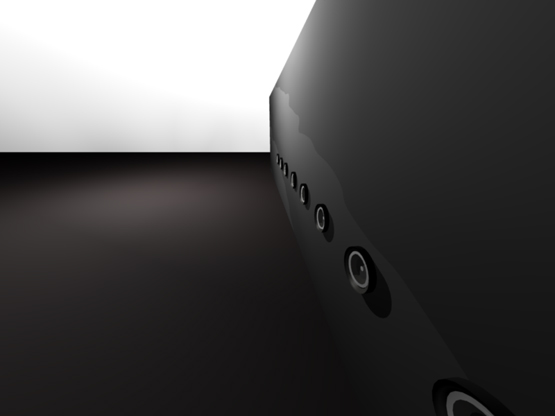
When someone screams in real life, do they hear us in
virtual reality?
Do they want to?
The proliferation of networked online worlds has provided a small quota
of the human race the option to seek refuge in utopian, less troubled
imaginary lands. Rolling synthetic green pastures offer us respite from
a planet undergoing exploitation and climate change. For those of us too
firmly rooted in this material world to join them, how shall we communicate
with them? In what way shall we lament their departure? The essence of
CATERWAUL is a large, monolithic, dark wall that is represented
both in the real and virtual worlds. It is a one-way portal to the virtual
world through which people can whisper their thoughts, scream their frustrations
and convey regret without the privilege of reply. It is a wailing wall
through which to mourn the loss of our humanity to the virtual network.
CATERWAUL is an interactive sound installation that operates
as a one way “portal” to Second Life via the internet.
A physical wall in Boston operates as a totemic locus of grief. People
approach it with intent to wail and mourn. The mourners grieve their lost
loved ones who spend more time in virtual and on-line worlds than they
do communicating in real life. The cacophony of the lamentation is recorded
by hidden microphones in the wall, transmitted across the internet and
piped out of an "identical" wall in the virtual world Second
Life. A website displaying a simulation of the wall allows other
people, on the threshold of "real" and "second" life,
to vicariously eavesdrop the wailing.
ENTER CATERWAUL
>> on turbulence.org
Performance:
CATERWAUL operates as a one way "portal" to
Second Life. Like
the Wailing Wall in Jerusalem, people approach it with the intent
to wail, and mourn. The mourners will be grieving their lost loved ones
who spend more time in virtual and on-line worlds than they do in real
life. Recorded by hidden microphones, their lamentations will be piped
into an "identical" wall in Second Life.
Celebrating the Ancient Roman tradition of hired mourners, a procession
of 6 men and 6 women will approach CATERWAUL wailing
and sobbing. Each will invoke the names of the people they are mourning.
Proske will then deliver a eulogy.
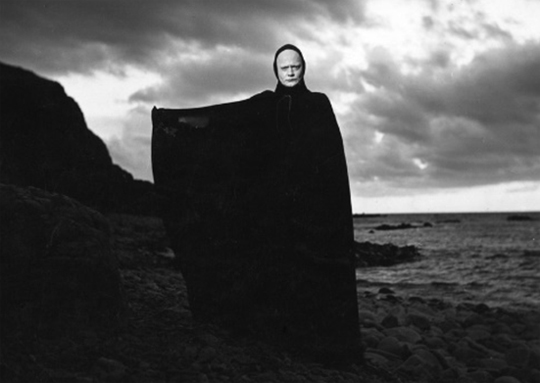
From Ingmar Bergman's "The Seventh Seal"
Pierre
Proske is an Australian electronic artist intrigued by the
pervasiveness of technology in culture and its relationship to nature.
After years of juggling parallel interests in technology and the arts,
Pierre tired of the schizophrenia and finally discovered that it was socially
acceptable, in fact highly desirable, to merge the two. Consequently he
has taken on the ambitious task of rendering computers
accountable to our sometimes misplaced but inevitable humanity.
Proske's work involves exposing the unspoken relationships
we have with technology and harnessing machines into exploring new aesthetics.
He has exhibited or performed in Australia, Sweden., Brazil, Japan and
the Netherlands.
Having studied Electrical Engineering and Liberal Arts at
the University of Melbourne, Australia, Pierre spent 4 years in Sweden
where he performed, exhibited and obtained a Master of Science in Art
and Technology from Chalmers University. His background in arts, engineering,
philosophy, music and literature provides him with sufficient options
to keep himself perpetually occupied in a self-inspired quest to weave
together several unrelated threads of activity.
Imaging Beijing
by John (Craig) Freeman
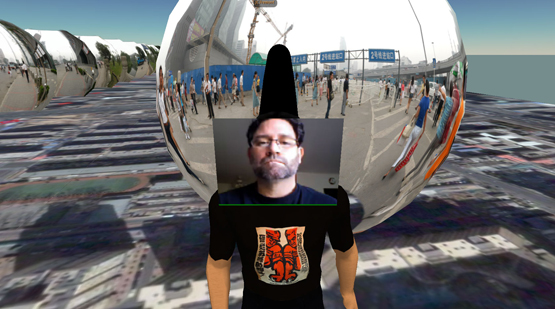
Imaging
Beijing is the latest installment of Imaging
Place, a place-based, virtual reality project that combines panoramic
photography, digital video, and virtual worlds to investigate and document
situations where the forces of globalization are impacting the lives of
individuals in local communities. The goal of the project is to develop
the technologies, the methodology and the content for truly immersive
and navigable narrative, based in real places.
When a denizen of Second Life first arrives at
Imaging Beijing, he, she or it can walk over a satellite
image of central Beijing where they will find a networks of nodes constructed
of primitive spherical geometry with panoramic photographs texture mapped
to the interior. The avatar can walk to the center of one of these nodes
and use a first person perspective to view the image, giving the user
the sensation of being immersed in the location.
Streaming audio is localized to individual nodes providing
narrative content for the scene. This content includes stories of formative
memory told by Peter Guo, a resident of Beijing, who appear in the images.
The work is projected nine by twelve feet in a darkened space with a pedestal
and a mouse placed in the center of the installation enabling the audience
to interact with it. A web-cam captures live video of the user and transmits
it to the head of an exhibition avatar. Dated links in the virtual space
launch a browser, which opens a web journal of the Imaging Beijing
field research.
ENTER IMAGING
BEIJING >> on turbulence.org
John
Craig Freeman's work has been exhibited internationally including
at The Museum of Contemporary Art, Beijing, the Kunstraum Walcheturm in
Zurich, Eyebeam in New York, City, the Zacheta Narodowa Galeria Sztuki
(the national gallery of Warsaw), Kaliningrad Branch of the National Center
for Contemporary Arts in Russia, Art Basel Miami, Ciberart Bilbao and
the Girona Video and Digital Arts Festival in Spain, La Biblioteca National
in Havana, the Contemporary Art Center in Atlanta, the Nickle Arts Museum
in Calgary, the Center for Experimental and Perceptual Art (CEPA) in Buffalo,
Art interactive, Mobius and Studio Soto in Boston, the Centro de la Imagen
in Mexico City, Ambrosino Gallery in Miami, the Photographers Gallery
in London, and the Friends of Photography's Ansel Adams Center in San
Francisco.
In 1992 Freeman was awarded an Individual Artist Fellowship
from the National Endowment for the Arts. His writing has been published
in Leonardo, the Journal of Visual Culture, and Exposure, as well as a
chapter in the book Electronic Collaboration in the Humanities. His work
has been reviewed in Wired News, Artforum, Ten-8, Z Magazine, Afterimage,
Photo Metro, New Art Examiner, Time, Harper's and Der Spiegel. Lucy Lippard
cites Freeman's work in her book The Lure of the Local, as does Margot
Lovejoy in her book Digital Currents: Art in the Electronic Age.
Freeman received a Bachelor of Art degree from the University
of California, San Diego in 1986 and a Master of Fine Arts degree from
the University of Colorado, Boulder in 1990. He is an Associate Professor
of New Media at Emerson College in Boston. The focus of his academic activities
throughout the last decade has been to integrate computer technology and
theory of electronic culture into visual art curriculum and to explore
interdisciplinary approaches to education and technology.
NO MATTER
by Scott Kildall and Victoria Scott
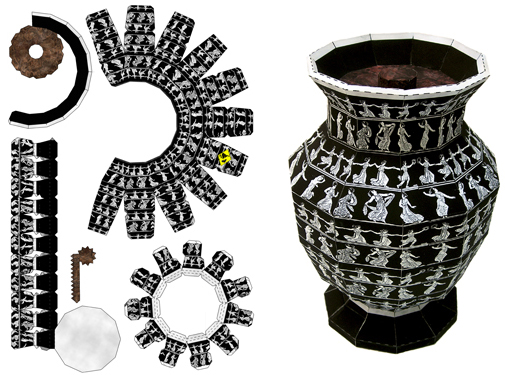
Pandora's Box/Jar: (in SL,as a 2d sheet and as a 3d paper object)
NO MATTER is an interactive installation
that activates the transformation of imaginary objects through the Second
Life virtual economy into physical space. Second Life builders
construct replicas of famous buildings, luxury goods and custom-designed
objects, first reproducing, then inverting the notion of value itself.
With zero cost for gathering resources, production of goods and transport
of finished product, these items proliferate widely and quickly. In the
real world, consumer items and imaginary objects serve as forms of emotional
attachment — projection screens for desire, fear and love. These
idealized forms seem real but when actualized in Second Life,
they simultaneously disappoint and fascinate.
Likewise, humans have long sought escape from the physical
world through both stories and invention, creating “imaginary objects”,
which embody the tension between the ideal and the real. These shared
cultural artifacts surface in mythology (Holy Grail, Trojan Horse), literature
(Tell-Tale Heart), film (Maltese Falcon), thought experiments (Schrodinger’s
Cat) and impossible inventions (Time Machine). Second Life, an
online social environment, offers similar possibilities of the imaginary.
With 3D-simulated space combined with a virtual currency and social interaction,
this is a fully functioning economy of the immaterial.
NO MATTER reflects this tension between
the imaginary and real economics by (1) commissioning 25 builders and
artists to produce 40 cultural artifacts in Second Life space;
(2) paying them in Linden dollars at an equivalent scale of $1.50 to $12.00
per object; (3) extracting the objects from Second Life —
a closed system where 3D models cannot be exported; (4) inviting volunteers
to reconstruct these as 3D paper replicas in physical space and paying
them the equivalent wages in Linden dollars.
ENTER NO
MATTER >> on turbulence.org
Scott
Kildall is cross-disciplinary artist working with video,
installation, prints, sculpture and performance. He gathers material from
the public realm as the crux of his artwork. Through this method, he uncovers
relationships between human memory and social media technology. He has
a B.A. in Political Philosophy from Brown University. In 2006, he received
a M.F.A. from the School of the Art Institute of Chicago through the Art
& Technology Studies Department. He has exhibited in Chicago, New
York, Los Angeles, San Francisco, Toronto, Helsinki, Ireland, Spain and
Romania. In the fall of 2006, he finished a conceptual art residency called
The Future of Idea Art at The Banff Centre for the Arts. He followed this
with a six-month fellowship at the Kala Art Institute focusing on remembrance
in simulated worlds. He also works with Second Front — the first
performance art group in Second Life. He currently resides in San Francisco.
Victoria
Scott is a visual artist who works with electronic media,
sculpture and social relations, both materially and as conceptual metaphor.
For over a decade she has researched and created large-scale installations,
objects, digital prints and audio works. Her ongoing projects include
the material depiction of personal simulations and psychological spaces
within online environments and real life. She is also developing a series
of batteries that are charged by emotional energy and microorganisms.
Born and raised in Winnipeg, Manitoba, Victoria graduated from the New
Media/Photo Electric Arts Dept., at The Ontario College of Art & Design.
In 2003, she was awarded the full Trustees Scholarship to attend at the
School of the Art Institute of Chicago within the Art and Technology Department.
Scott completed her MFA in 2005. She has exhibited in Sweden, Mexico City,
Toronto, Berlin, Boston, Miami and Chicago and is the recipient of grants
from both the Canada and Ontario Arts Councils.
Remote
by Neill Donaldson, Usman Haque, Ai Hasegawa, Georg Tremmel

Remote connects together two spaces, one
in Boston the other in Second Life, and treats them
as a single contiguous environment, bound together by the internet so
that things that occur in one space affect things that happen in the other
and vice versa -- remotely controlling each other. Communication between
the two halves of this extended environment is a complex choreography
coupling the environmental phenomena of humidity, temperature, light,
speech, mist, wind, sound and proximity across the two. The object in
Boston appears to be a seat; but, experientially, the Second
Life space appears to be inside the seat. A similar alteration of
scale occurs in the other direction. Visitors to the Boston space
and the Second Life space must negotiate to achieve goals: e.g.
by sitting down, breathing, touching, knocking, colliding. The environmental
data of both spaces is publicly available in realtime via the EnvironmentXML
repository enabling others to build devices and spaces that connect directly
to both Boston and Second Life. The intention is to
explore an architecture that is resolutely "human" (in the sense
of being inhabited, configured and determined by its occupants) yet context-free
(because it does not privilege geographical location).
ENTER REMOTE
>> on turbulence.org
Neill Donaldson is a programmer
specialising in Java & Ruby/Rails. By day Neill works with Ruby on
Rails for a startup in London. By night he works with Ruby on Rails for
a startup in London. If he had more time, he'd return to his beloved arduino
board, or maybe his interactive toys in Second Life.
Usman Haque, Haque
Design + Research, architect and programmer, UK, has created responsive
environments, interactive installations, digital interface devices and
mass-participation performances. His skills include the design of both
physical spaces and the software and systems that bring them to life.
Ai Hasegawa, Haque
Design + Research, illustrator and interaction designer, studied at
the International Academy of Media Arts and Sciences in Japan. She spends
most of her time in the world of manga but when she occasionally comes
back to this planet she specialises in Flash with a little bit of Processing.
Georg
Tremmel, Japan/Austria, studied Media Art in Vienna and Interaction
Design at the Royal College of Art in London. His body of work mainly
consists of interactive installations, of both the physical and meta-physical
kind.
The Vitruvian World
by Michael Takeo Magruder, Drew Baker and David Steele
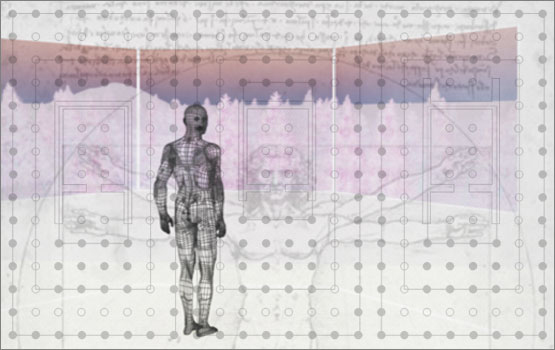
In the 1st century BC, Roman writer, architect and engineer
Vitruvius authored specific building formulae based on the guiding principles
of strength, utility and beauty. For him, architecture is intrinsically
linked to nature and is an imitation of cosmic order. The most well-known
interpretation of this postulate is the Vitruvian Man by Leonardo
da Vinci in which the human form is depicted in unity with the square
and circle - representing material and spiritual existence respectively.
This tripart union of human body, material form and spiritual
essence maintains relevance within the current climate of distributed
presences, mixed realities and internet cultures. The proliferation of
synthetic worlds and virtual constructs engendered by our technologically-enabled
mainstream provides new realms for creative exploration and actual existence.
The Vitruvian World is a real-time immersive
installation that embodies the principles of Vitruvius within this contemporary
context. Existing in three distinct yet interconnected spaces, the artwork
simultaneously embraces the virtual, the physical, and the network that
connects them.
ENTER THE
VITRUVIAN WORLD >> on turbulence.org
Michael
Takeo Magruder is an American artist based in the UK working
with New and Technological Media within Contemporary Arts practice. His
artworks have been showcased in over 180 exhibitions and 30 countries,
including venues such as the Courtauld Institute of Art, London, EAST
International 2005, Georges Pompidou Center, Tokyo Metropolitan Museum
of Photography and Trans-Media-Akademie Hellerau. His works are regular
inclusions in international New Media festivals, such as Cybersonica,
CYNETart, FILE, Filmwinter, SeNef, Siggraph, Split, VAD and WRO. His artistic
practice has been funded directly by the Esmée Fairbairn Foundation,
Arts Council England, The National Endowment for the Arts, USA and numerous
public galleries both within the UK and abroad. Michael is also recognized
for his on-line arts practice and has been commissioned by leading portals
for Internet Art such as Turbulence.org and Soundtoys.net. His current
interests concern the simultaneous utilization and dissection of new technology
as a means to explore the formal structures and conceptual paradigms of
the digital realm. He seeks to create artworks in which there are no divisions
between technologies, aesthetics, and concepts.
ENTER THE
VITRUVIAN WORLD >> on turbulence.org
Drew Baker is a Senior
Research Fellow within the Centre for Computing in the Humanities, King’s
College London. One of the founding members of King's Visualisation Lab,
he has worked in the field of archaeological 3D visualization and interpretation
for over ten years. His specialization is in the area of 3D modeling -
specifically interactive web-based environments and constructs. Drew’s
primary interest in deploying 3D and advanced technologies within cultural
practice is to transform spectators into active participants though the
utilization of virtual worlds and artifacts. He is currently concluding
a two year AHRC-funded project exploring the process of cognitive modeling
in 3D environments and how visualization methodologies can be recorded
and understood.
David Steele is a
senior technical consultant based in Arlington, Virginia, USA working
with advanced web technology and database architecture. He has been undertaking
research and development in these fields since the middle nineties and
was a pioneer in pairing cutting-edge clients to existing corporate infrastructures.
David’s work has enabled a variety of high profile applications
from global text messaging frameworks to re-entry systems for the space
shuttle. He is currently interested in exploring the limits of what code
can run in a browser in order to reduce server load and enhance the user
experience. The ultimate goal is for users to forget that they are working
in a browser as the web converges with native applications.
Thanks to King's Visualisation Lab, Centre for Computing
in the Humanities, King's College London for their generous support.
 |







